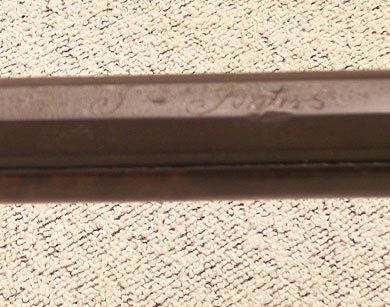 |
 |
 |
 |
 |
 |
 |
Kentucky Rifle signed “John Gonter” Lancaster County, PA Ca 1815 In 1776 John Gonter, at the age of 14, was excused from service in the Lancaster Militia to continue apprenticeship in the gunsmith trade and to make guns for the Continental Army. After the war he established himself in Hagerstown, MD and took on many apprentices during the 1790’s. In 1801 he relocated to Columbia, Lancaster County where this example was produced. He then moved to Berks County in 1824 at the age of 62 to continue in the trade.
This is unquestionably his finest example produced while in Columbia, PA. with outstanding details that set it apart from the usual Lancaster County rifle. Of great significance is the relief carving on the butt stock in the form of two intertwined serpents. Two other Lancaster gunsmiths used a similar carved motif, though not as masterfully, thus establishing a rare regional characteristic as noted by Kindig in the 1960’s. Interpreting the symbolism associated with these serpents is not clear. I believe they represent opposing forces of good and evil. Nevertheless they represent a rare instance of animal carving designed within the rococo vocabulary. The patch box is well designed, masterfully and deeply engraved, and well fitted to the butt stock. Engraving on the lid echoes that on the side plate; and the cross hatching is effectively used in both engraving and carving. Gonter and few other gunsmiths could engrave and carve with equal brilliance using similar design elements creating continuity in overall design (refer to John Noll and Simon Lauck examples pictured on this site). The lid release is hidden under a section of the toe plate. Curly maple of a high grade was used in stocking this rifle. A very desirable and attractive surface enhances both its value and beauty. Recently, a tiny repair to the stock was made at the back of the lock mortise where, in the day, the tight fitting lock was carelessly removed. Another was made surrounding the trigger pin by the side plate. Just like today, I believe the owner/do-it-yourselfer was responsible for these little mishaps. This is one of the few early rifles where no cracks or losses are seen at the toe indicating light careful use. The fore stock is complete with no repairs or replacements. The fore end cap is original.
An interesting punched design is seen at the breech of the 44 inch octagonal barrel. The initials “A J” are also stamped at the breech identifying Jacob Andrews as the barrel maker. John signed the barrel is script with an intentional “s” or “5” added after his name. I have not yet interpreted this addition. Brass mounts are well made as expected and are held tight to the stock with no damage. Rifles that possess good condition, good artistic expression, and good architecture, are a rarity. Unique artistic details on a rifle that are well done enhance desirability. However, if you find a rifle with these combined attributes it can enhance any collection, or stand alone as a collection in its self. Sold 2/2010
|
Home • Services • Current Inventory • Terms & Conditions • Events • Contact
©2009 Aspen Shade Ltd.
Website Design by Brandon Bloodworth

















